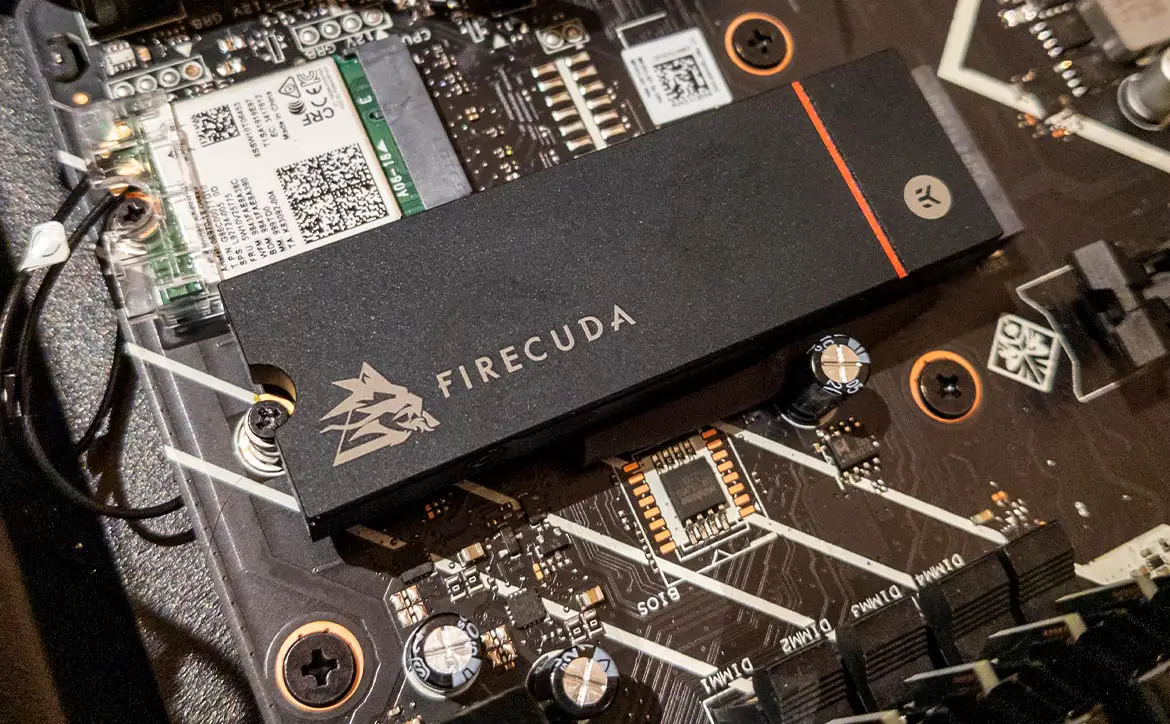![[UPDATED] Seagate FireCuda 530 Heatsink review: A blazing-fast Gen4 SSD with a price tag to match 1 TOP PICK 2022 TOP OF ARTICLE](https://techaeris.com/wp-content/uploads/2021/12/TOP-PICK-2022-TOP-OF-ARTICLE.png)
With games becoming more demanding on systems with each release, fast, high-capacity storage is a must. There are several options available on the market today, and the latest is PCIe Gen4 M.2 SSDs that offer blazing speeds.
Estimated reading time: 13 minutes
Our Seagate FireCuda 530 Heatsink review looks at a PCIe Gen4 M.2 SSD for PC and PlayStation 5 consoles with a heatsink to help dissipate heat for better and longer performance. Read on for our full review and find out why it earned a Top Pick of 2022 Award here at Techaeris.
[UPDATED 01/29/2023]: Since we reviewed this drive back in March 2022 on a desktop PC, my son managed to get his hands on a PlayStation 5. Check the installation and performance sections below to see how easy it was to install and how it performed as a second drive for the PS5.
Table of contents
Specifications
The Seagate FireCuda 530 Heatsink M.2 SSD (ZP4000GM30023) we reviewed has the following features and specifications:
- Speed Reigns: FireCuda 530 dominates the SSD lineup—delivering pure performance, absolute power, the most advanced components, and unrivaled endurance.
- Absolute Performance: At up to 7,300MB/s you can harness the full power of PCIe Gen4 speeds to dominate next-generation games and applications.
- Cool Speed Ahead: Heatsink technology keeps things cooler to maintain performance longer.
- Storage Expansion for PS5™: The FireCuda 530 heatsink is compatible with PS5 consoles and meets PS5 specs on performance and dimensions for an easy drop-in expansion solution with no additional parts needed.
- Fastest. FireCuda. Ever.: Built for sustained, pro-level gaming and accelerated content creation with transfer speeds up to 2× faster than PCIe Gen3 NVMe SSDs and up to 12× faster than SATA SSDs.
- Latest Tech: Built with a Seagate-validated E18 controller and the latest 3D TLC NAND, FireCuda 530 provides the most advanced speed and durability so you can push the limits of your machine.
- Endurance Unleashed: Designed to perform under heavy use and tough enough to go the distance—up to 5100TB TBW means you can write and delete 70% of the drive capacity, every day, for five years.
- Rescue Services: Rest easy with three years of Rescue Data Recovery Services, offering an industry-leading 95% success rate against unexpected data loss.
| Model | ZP4000GM30023 |
| Capacity | 4TB (2TB, 1TB, 500GB models available) |
| Interface | PCIe Gen4 x4 NVMe 1.4 |
| NAND Flash Memory | 3D TLC |
| Sequential Read (Max, MB/s), 128KB | 7,250 |
| Sequential Write (Max, MB/s), 128KB | 6,900 |
| Random Read (Max, IOPS), 4KB QD32 T8 | 1,000,000 |
| Random Write (Max, IOPS), 4KB QD32 T8 | 1,000,000 |
| Total Bytes Written (TB) | 5100 |
| Mean Time Between Failures (MTBF, hours) | 1,800,000 |
| Rescue Data Recover Services (years) | 3 |
| Warranty, Limited (years) | 5 |
| Active Power, Average (W) | 8.6 |
| Idle Power PS3, Average (mW) | 30 |
| Low Power L1.2 mode (mW) | <5 |
| Temperature, Operating Internal (°C) | 0°C – 70°C |
| Temperature, Non-operating (°C) | -40°C – 85°C |
| Shock, Nonoperating: 0.5ms (Gs) | 1,500 |
| TRIM | Yes |
| S.M.A.R.T. | Yes |
| Halogen Free | Yes |
| RoHS Compliance | Yes |
| Software | DiscWizard, SeaTools |
| Dimensions (LxWxH) | 80.16 x 24.2 x 11.04mm (3.156 x 0.953 x 0.435in) |
| Weight | 47g (0.104lb) |
What’s in the box
- Seagate FireCuda 530 M.2 SSD (w/ optional heatsink)
- Quick Start Guide
- Rescue Data Recovery Services (3 years included)
- Warranty Guide (5-year limited warranty)
- Stickers
Design
For the most part, a PCIe Gen4 NVMe SSD has one look. Thin, slim, and long. The FireCuda 530 Heatsink PCIe Gen4 NVMe SSD is no exception. It is just over three inches in length and about an inch wide. Where it differed from other NVMe SSDs is the heatsink. The heatsink does add some minimal height to the SSD — 7.43mm (0.294″), so you’ll need to make sure it fits in your system. While it should fit in most desktops and the PS5 console, you may have issues with installing it into a laptop.
The heatsink on the FireCuda 530 SSD is a high-grade aluminum block with gunmetal anodization. According to Seagate, this helps dissipate heat which in turn helps minimize thermal throttling and maximizes performance. The heatsink itself is pretty slim and slick, with the FireCuda branding an orange stripe on it.
![[UPDATED] Seagate FireCuda 530 Heatsink review: A blazing-fast Gen4 SSD with a price tag to match 2 The Seagate FireCuda 530 Heatsink PCIe Gen4 NVMe SSD is a bit thicker than normal due to the heatsink](https://techaeris.com/wp-content/uploads/2022/03/Seagate-FireCuda-530-Heatsink-review-02.jpg)
Installation
Desktop PC
If you’ve installed an NVMe SSD before, this is a no-brainer. All you need to do is find a spare NVMe port on your system, remove the single screw, slide the FireCuda 530 Heatsink SSD into place, push the opposite end, and screw it in place. If replacing your primary drive, you must clone it first unless you want to set up your system from scratch again.
PlayStation 5
The FireCuda 530 Heatsink SSD is also compatible with the Sony PlayStation 5 console. Seagate has an excellent article on how to install one into your PS5, and installation is pretty easy. After making sure your PlayStation 5 is up to date, disconnect all cables and move it to a clean workspace. With the console upside down (the PS logo facedown), grip the bottom-right and top-left corners of the bottom cover, gently lift the right side and slide the cover off to the left.
Once the cover is removed, remove the screw from the expansion slot cover. Next, remove the spacer screw and move the spacer to the groove marked “80.” Insert the Seagate FireCuda 530 with the heatsink facing up and the notch resting on the spacer. As it is compatible with the PlayStation 5, the FireCuda 530 with the heatsink fits perfectly inside the SSD expansion slot in the console. Once installed, insert the spacer screw through the spacer and tighten it back in place. Next, reattach the expansion slot cover and fasten it into place. Finally, place the bottom cover back on your PlayStation 5 by placing it slightly to the left, then slide it back towards the right until you hear a click.
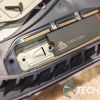
Plug your console back in, turn it on, and you will receive a prompt to format your M.2 SSD storage, accept it and you’re good to go. Once formatted, you can go into your PlayStation 5 settings and move existing game installations and/or set the default installation location to your newly installed and formatted FireCuda 530 SSD.
Software
You can easily use the FireCuda 530 NVMe SSD without software. However, Seagate includes this drive and two software tools, and a recovery service.
DiscWizard
If you install anything, you’ll want to install the Seagate DiscWizard Windows application, a dumbed-down version of Acronis, a popular and solid disk management tool. Once installed, you can use the app to clone an existing disk to the FireCuda 530 Heatsink SSD, build rescue media, add a new disk to your system, and clean your drive. Some other options are feature-locked, like Acronis Universal Restore, Try & Decide, and Acronis Secure Zone. Selecting any of these will direct you to a purchase page to purchase a full version of Acronis.
At any rate, I used the app to clone a 2TB SSD to the 4TB FireCuda 530. The process is pretty straightforward and allows you to quickly clone with default automatic settings (recommended) or manual settings, allowing you to adjust the size of partitions, what gets copied, and more.
I’m not sure if it was an issue with the software or the system I was using, but it said it would take about 2 hours. With about an hour and a half left, the timer quit and said the process had been completed. However, the system couldn’t read the drive. I swapped out for the primary drive and booted up the system to no avail. I reverted to the original SSD, put the FireCuda in the external enclosure I was using and the system couldn’t find it. I had to end up putting it in another system and reformatting it. Once reformatted, I put it back in the enclosure and re-cloned it. While it did complete much sooner than the two hours indicated, the FireCuda 530 worked as the primary drive in the machine I wanted.
SeaTools
SeaTools is meant to be installed and runs in the background, monitoring your drives (both Seagate and other OEM drives). It will offer limited functionality with non-Seagate drives, however. On that note, with it, you can check the health of your SSDs, run quick and extended tests, adjust the max LBA (not recommended), tunable capacity, spin down the drive, update the firmware, erase the drive, create a bootable SeaTools drive, and manage logs. It’s pretty simple but does what it’s supposed to.
Rescue Data Recovery Services
The Seagate FireCuda 530 M.2 SSD also comes with three years of the company’s Rescue Data Recovery Services. You can find more information about this on their website.
Performance
Desktop PC
With its PCIe Gen4 NVMe interface, latest 3D TLC NAND, and Seagate-validated E18 controller, you’d expect fast performance with the FireCuda 530 Heatsink NVMe SSD. On its website, Seagate states the drive is capable of read speeds of up to 7,300MB/s and 6,900MB/s write speeds. This does depend on size, with the 2TB and 1TB models capable of 7,300MB/s read speeds, the 4TB a slightly slower 7,250MB/s, and the 500GB version 7,000MB/s. When it comes to read speeds, the 500GB is pretty slow at 3,000MB/s while the three other capacities all top out at 6,900MB/s.
Of course, we ran the FireCuda 530 Heatsink 4TB PCIe Gen4 NVMe SSD through a few different benchmark programs and compared it with the WD_BLACK Gen4 drive and some older Gen3 PCIe NVMe SSDs. Check out the results in the table below:
| FireCuda 530 Heatsink 4TB | WD_BLACK Gen4 SDCPNRZ-2T00-1106 2TB | Samsung 950 PRO | WD Black SN750 | Sabrent Rocket Q 1TB | |
| CrystalDiskMark Seq Read | 7,048 MB/s | 6,964 MB/s | 2,964.1 MB/s | 3,367 MB/s | 3,355 MB/s |
| CrystalDiskMark Seq Write | 6,768 MB/s | 5,215 MB/s | 1,548.4 MB/s | 2,960 MB/s | 2,072 MB/s |
| AS SSD Seq Read | 5,489 MB/s | 5,169 MB/s | 2,783.59 MB/s | 2,876MB/s | 2,635MB/s |
| AS SSD Seq Write | 4,862 MB/s | 4,309 MB/s | 1,305.24 MB/s | 2,044MB/s | 1,846 MB/s |
| ATTO Seq Read | 5,730 MB/s | 5,660 MB/s | – | – | – |
| ATTO Seq Write | 4,860 MB/s | 4,890 MB/s | – | – | – |
As you can see, different apps do report differently depending on the parameters. CrystalDiskMark was the closest to the 7,250MB/s max sequential read and 6,900MB/s max sequential write. It is a fast drive, barely beating a 2TB WD_BLACK Gen4 NVMe SSD in read performance but easily besting it when it comes to the write department on some tests.
As far as reliability and endurance are concerned, Seagate mentions that the FireCuda 530 Heatsink PCIe Gen4 NVMe SSD can sustain:
- 0.7 Drive Writes per Day—fill and delete 70% of the drive capacity, every day, for five years
- 1.8 Million Hours Mean Time Between Failures for trusted reliability
- Up to 5100TB Total Terabytes Written—durability delivered
Given the performance and endurance specifications, this drive should last you for quite a few years, hopefully without issue. In the event it does fail, you can use the aforementioned included Rescue Data Recovery Service from Seagate.
PlayStation 5
The default SSD inside the PlayStation 5 has a read/write speed of 5,500MB/s. As you can see, the FireCuda 530 is rated for up to 7,500MB/s write and 6,900MB/s read speeds — a pretty decent increase in both read and write speeds for the drive. When we installed it, the console indicated a 6,327MB/s read speed on the FireCuda 530. Based on those numbers, the FireCuda 530 is 1.15 times faster in reading data. In other words, it should be about 15% faster when reading data. As such, we should see about a 15% decrease in load times, which as I’ve seen in the past does vary based on the game and system.
For testing purposes, we loaded up God of War on the internal drive and tested the times to load to the main screen, paused the timer, then continued the timer for the total time it took to load into the game once we pressed continue. After that, we moved the game to the FireCuda 530 and performed the load test again. In case you were curious, it took the system 1 minute and 41 seconds to move 130.2GB of data (both God of War and God of War Ragnarök). Not too shabby.
Firing up God of War while installed on the internal SSD took 26.79 seconds to hit the loading screen. Pressing continue, and it took a total of 49.76 seconds before we could play the game. When installed on the FireCuda 530, it was a little bit faster taking 23.76 seconds to hit the main screen and a total of 43.60 seconds before it was playable. While not exactly 15% faster, loading to the main screen was about 12% faster and it was playable 14% faster loading off the FireCuda 530. Sure, we’re talking 3 to 6 seconds faster here, but load times would also be reduced between deaths, loading screens, and the like. Over time, it definitely adds up bit by bit.
Minor speed increase aside, another reason you’ll want to install a second M.2 SSD into your PlayStation 5 is to increase your storage capacity. Although the console has a 1TB internal drive, only 667.2GB is available for games. Given the size of some games these days, that leaves you with room for anywhere between 5 and 10 AAA titles. To be honest, my kid lucked out here with the 4TB version as he’ll be set for quite a while to come.
Price/Value
High-capacity PCIe Gen4 storage isn’t cheap. Starting at US$169.99/CA$215.99 for the 500GB version, the 4TB version will set you back a whopping US$1018.99/CA$1301.99 — close to the price of two PlayStation 5 consoles. Interestingly enough, the 4TB heatsink version only costs an extra US$19/CA$26 over the regular version. In that case, it is a no-brainer if you’re shelling out this kind of money for the drive to get the heatsink and add to the longevity of the drive.
That said, it appears to be on sale on Amazon right now with prices ranging between US$119.99 for the 500GB version and US$899.99 for the 4TB version. Personally, given the write performance on the 500GB model, I’d stick with the 1TB and up. As for the competition, Seagate’s pricing does seem to be fairly in line with a few off-brand exceptions that are much lower but also come without a heatsink. The scoring for this section is based on an average for all four sizes, if it was based on the 4TB alone, it’d be around a 7/10.
Wrap-up
If you’re looking to expand the storage in your gaming PC or PlayStation 5, the Seagate FireCuda 530 Heatsink SSD is a great choice. While the 4TB version is expensive, the 1TB and 2TB are more reasonably priced and will provide ample additional fast storage. As mentioned in the previous section, I’d personally skip the 500GB version due to its lower max write specifications.
Because of its performance and PlayStation 5 compatibility and improved performance gains on the console, the Seagate FireCuda 530 Heatsink PCIe Gen4 NVMe SSD earns a Top Pick of 2022 Award here at Techaeris.
In some of our articles and especially in our reviews, you will find Amazon or other affiliate links. As Amazon Associates, we earn from qualifying purchases. Any other purchases you make through these links often result in a small amount being earned for the site and/or our writers. Techaeris often covers brand press releases. Doing this does not constitute an endorsement of any product or service by Techaeris. We provide the press release information for our audience to be informed and make their own decision on a purchase or not. Only our reviews are an endorsement or lack thereof. For more information, you can read our full disclaimer.
Last Updated on March 13, 2024.

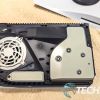
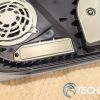
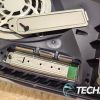
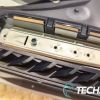
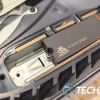
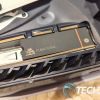
![[UPDATED] Seagate FireCuda 530 Heatsink review: A blazing-fast Gen4 SSD with a price tag to match 3 Screenshot of the main screen of the Seagate DiscWizard Windows application](https://techaeris.com/wp-content/uploads/2022/03/Seagate-DiscWizard-FireCuda-530-Heatsink-review-screenshot.jpg)
![[UPDATED] Seagate FireCuda 530 Heatsink review: A blazing-fast Gen4 SSD with a price tag to match 4 The Seagate FireCuda 530 Heatsink PCIe Gen4 NVMe SSD offers great performance](https://techaeris.com/wp-content/uploads/2022/03/Seagate-FireCuda-530-Heatsink-review-03.jpg)
